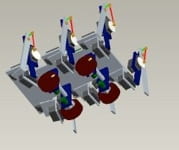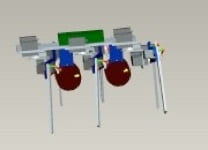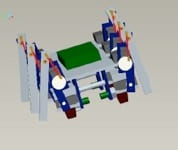
The main idea behind the hardware component of this research project is to design, build, and control a low-cost mobile robot that can use both legs and wheels. Some of the legged-wheeled robots that currently exist have their wheels attached to an actuator located at the end of the robot leg. When the robot is commanded to walk, the wheel is stationary and the robot actually walks on its wheel. This causes a number of problems that hinders long-term and robust operation in remote environments.
The ByroBot was designed with 6 legs and 4 wheels. Each leg has 3 servo motors to provide 3 degrees-of-freedom for instituting a walking pattern. Each wheel is attached to a DC motor for 4-wheel drive. The robot body material is polycarbonate plastic (which is nice and robust, and more lightweight than aluminum or some other metal). The robot is able to drive on its 4 wheels and roll over obstacles, as well as have the legs retract up (as you see in the CAD model and in the videos), so it can stand and walk in its legged configuration for navigating over larger obstacles. The Eyebot is the primary controller for this robot. It can be programmed in either C or Assembler language. An additional controller, the Servo Controller, is interfaced with the Eyebot to allow control of up to 32 servo channels. The Eyebot and the Servo Controller are able to communicate through their serial COM ports using a female-to-female null modem.
ByroBot
Lead Engineers: Byron Johns, Ayanna Howard
| SnoMotes | Arctic Navigation | Robot Surveying |
When ByroBot stands, it is primarily supported by the high-torque servos that are at the “hip joint” of each leg. Joint torques were calculated to determine the torque needed for theses servos so that ByroBot could support itself standing. Kinematic analysis is done for the wheels to find velocity and position data, as well as the radius of curvature of the robot motion using different linear velocity of the wheel pairs in its differential drive. Forward kinematic analysis was also done for the legs to find their “foot” positions based on the servo motor angles, which controls the joint positions. By locating the position of the feet that are in contact with the ground, a polygon of support can be determined for the robot while standing. Keeping the robot body center of mass inside this polygon of support at all times while walking will allow for optimum stablility of the Byrobot.
Why do we want these specifications?
The development of a new family of robotic vehicles for use in the exploration of remote planetary surfaces, such as Mars, and remote sites on Earth, such as Antartica, is an ongoing process. Current robotic vehicles must traverse rough terrain having various characteristics such as steep slopes, icy surfaces, and cluttered rock distributions, to name a few. The goal of the Byrobot project is to design a new robotic mobility system that performs to optimum capability in remote environments, which leads to the idea of the Legged-Wheeled robot.
Science exploration in unknown and uncharted terrain involves operating in an unstructured and poorly modeled environment. Several designs are plausible for operating in these types of environments. In order to guarantee success of robotic missions for the future, technologies that can enable multi-rover collaboration and human-robot interaction must be matured. The main hurdle with this focus is the cost and system complexity associated with deploying multiple robotic vehicles having the capability to survive long periods of time, as well as possessing multi-tasking capability. To address this issue, this research focuses on modularizing both hardware and software components to create a reconfigurable robotic explorer. The new Legged-Wheeled design robot possesses wheels, as well as legs, thus giving the robot the ability to traverse various terrains.
Field mobile robots must traverse long distances on hazardous terrain safely and autonomously using uncertain and imprecise information. Research such as traversability analysis, deliberative path planning with pre-stored terrain maps and embedded reactive behavior have been used to address the problems of navigation in natural terrain, but the process of successfully navigating between two designated points in rough terrain with minimal human interaction is still an open issue. Legged robots, versus wheeled mobility platforms, offers many advantages due to their ability to traverse a wide variety of terrain, but the control of walking poses special challenges in natural environments. Even simple legged-robot platforms have a large degree of coupled interactions and no single walking gait is suitable for all terrain surfaces. Walking surfaces can vary in a number of factors including traction properties, hardness, frictional coefficients, and bearing strength. To successfully operate within varying terrain environments, an automatic gait adaptation method for field mobile robots is a desirable quality. The focus of our work is therefore on the development of a methodology that learns new walking gaits autonomously while operating in an uncharted environment, such as on the Mars planetary surface or in the remote Antarctica environment.







